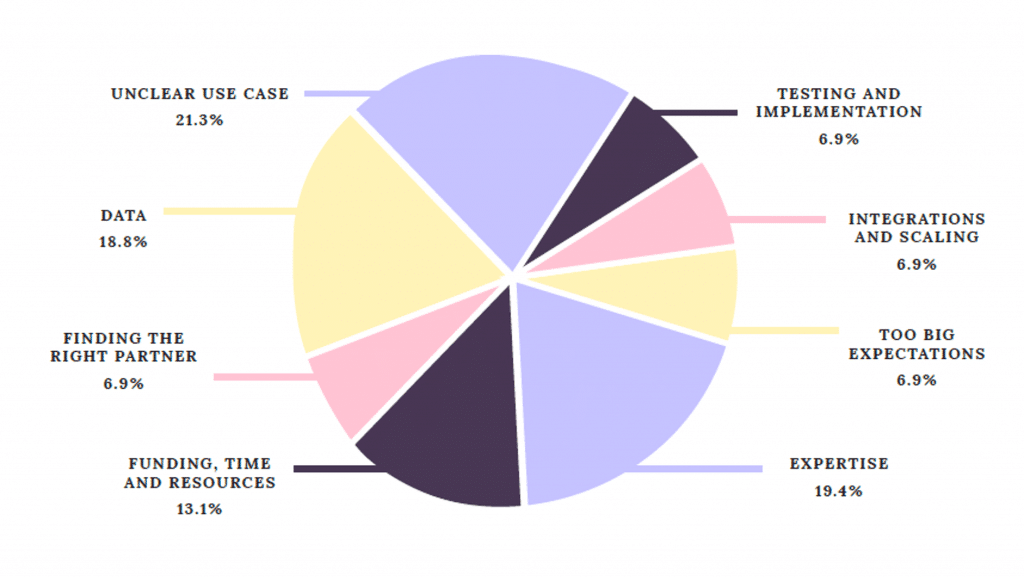What’s common between public speaking, energy transition, climate change, and radiotherapy? For each of them, AI transformation will help to create more customer value.
In October, I participated as a speaker or panelist in several events on AI transformation. The Insead webinar INTHECASE focused on the AI transformation of the German energy utility company E.On. A roundtable hosted by The Innovator discussed the state of AI-decision making. Jennifer was also kind to interview me about the challenges of scaling artificial intelligence across the enterprise. Demystifying AI got us excited in the AI Nordic. And finally, Avanto Ventures in Helsinki focused on AI and Innovation. It is always great to interact with brilliant minds from whom you can learn.

In all of these discussions, I was surprised by one thing. It seems like many companies are still struggling to figure out how to start their AI transformation. Therefore, I wanted to summarize my key takeaways for business leaders from these events. And provide concrete examples of companies who have already started their AI transformation journey.
So lets’ start my list of 6 things you need to know about AI transformation.
#1 AI transformation changes the way how companies deliver value to the customer
Just developing an AI model for a specific task won’t transform your business. It would help if you had a more fundamental change, a new business model. AI transformation changes the way how companies deliver value to customers. To do this, companies need to integrate AI into their business processes. Therefore, AI transformation impacts employees’ tasks and organization.
For example, E.ON is advancing energy transition with AI transformation. AI is answering fundamental questions and solving problems. For instance, AI predicts energy prices, consumption, and demand. This helps to create value through AI-powered customer-facing products, for example, smart homes. Read more in this excellent white paper by Insead.
Allianz subsidiary IDS GmbH – Analysis and Reporting Services provides information on companies to their customers. Impact investing is on the rise. Hence, IDS needs more accurate information on ESG (environmental, sustainability, and governance) targets and companies’ actions.
For this purpose, IDS developed an AI solution with natural language processing (NLP). With NLP, it reads ESG reports, often in PDF format, and makes them searchable and transparent. The application is unique in the way it captures the qualitative nature of corporate activities related to emissions and reduction-ambitions and can answer questions like “what,” “when,” and “by how much.”

The solution provides better and faster qualitative and quantitative information. Hence, clients can make more agile and smarter decisions.
Another financial sector example of AI transformation is Ant Financial. Read about 5 steps on how it built a 200 billion dollar platform business.
AI transformation helps SMEs
But it is not just large high tech companies that benefit from AI. It helps small and midsize enterprises (SME), too. One of the most compelling AI transformation cases is a Finnish speaker bureau MySpeaker. The founder André Noël Chaker is a witty character with a big smile. And he is a great speaker too.

I met with Andre during the pandemic in April. The meeting led to the development of an AI-powered public speaking learning platform, MySpeaker Rhetorich. It uses speech processing and computer vision technologies to analyze your speech and improve it. A local expert company has transformed itself into a global service. And hence, it will benefit millions of aspiring speakers. The service provides much higher value for customers than just booking their next speaking event.
#2 With an unclear business case, it is hard to progress
State of AI in Finland 2020 report highlights obstacles for AI transformation. On top of the list is “unclear business case”.

There is still a lack the understanding of what AI can do. And how companies can apply AI into their business. But what can you do about it? You cannot expect AI gurus to drop in and tell what to do in the business.
Companies and their employees need to become more AI literate. Therefore, they require education and training. An excellent example is E.ON. It made a specific effort to increase data and AI literacy in the company. Hence, it organizedtraining on visualizing and interacting with data from inside and outside the company.
With a proper understanding of AI, E.ON defined value pools where they saw the most significant opportunities for AI. For example, smart assets and networks and AI-assisted energy economics. AI is not about technology but driving tangible value.
#3 Without management support, AI transformation is damn hard
Management cannot delegate AI. AI transformation touches large parts of the company. Hence, it is essential to have top management backing the change. Leaving AI to R&D or the IT department alone will most likely fail.
Management needs evidence of progress. Small-scale experiments go a long way to build trust. However, one should not make the mistake of thinking that a working proof of concept is production-ready. Scaling AI is more challenging and requires a step-by-step approach. For example, AI might require the deployment of new data infrastructure. Or employees need to be trained as AI changes current processes.
The board and management should define strategic priorities and focus areas. In this way, employees know where to put their effort.
And you need to manage emotions on the way.
#4 Raw data is not enough
AI learns from data. For training AI, AI scientists need labeled data. I.e., data with meaning. Just having raw data is not enough. For example, teaching a self-driving car requires millions of photos and videos where objects like vehicles and pedestrians are marked, i.e., labeled.
Often, companies focus on collecting data. But to get meaningful results for AI transformation, one needs to create a workflow for labeling, also called annotation. Your AI might not be the best when you start. But the use of AI creates new data that improves AI. Like Tesla teaches its AI using its fleet of vehicles that collect new data while on the road.
#5 Companies using external AI talent create more value
Of course, you think I would say that. After all, I’m a co-founder and chairman of an AI consultancy. But let me explain. With an external, large AI talent pool, you can find exactly the expertise you need. In contrast to hiring a few internal experts whose skills might not be suited for all tasks. With external talent, you can complement your own in-house AI team for specific skills that might be very rare.
Or maybe you want to start with a part-time resource rather than hiring your own full-time person. Many Silo AI customers have started with a part-time AI scientist to get started. Rather than creating a massive AI project, they integrate an AI expert into on-going projects to begin to work with data and AI models. This incremental, iterative way of working is effective and flexible.
#6 AI transformation won’t make people obsolete
AI is not about technology. To drive change, you need people. Value is not created by automation but by enhancing people’s capability to be more creative. Most of the AI use cases are people-centric.
AI does the pre-work and helps humans to make better decisions. Philips and Silo AI developed a computer vision solution to analyze MRI images. It detects organs automatically for 3D segmentation. This solution could generate information that humans use for novel radiotherapy planning purposes. Thus, it can reduce repetitive manual work and support patient-centric care in radiotherapy.
Conclusions
I hope this helps you to accelerate your AI transformation journey. Thus, remember these six things:
- AI transformation changes the way how you deliver value to the customer;
- With an unclear business case, it is hard to progress;
- Without management support, AI transformation is damn hard;
- Raw data is not enough;
- Companies using external AI talent create more value;
- AI transformation won’t make people obsolete.
